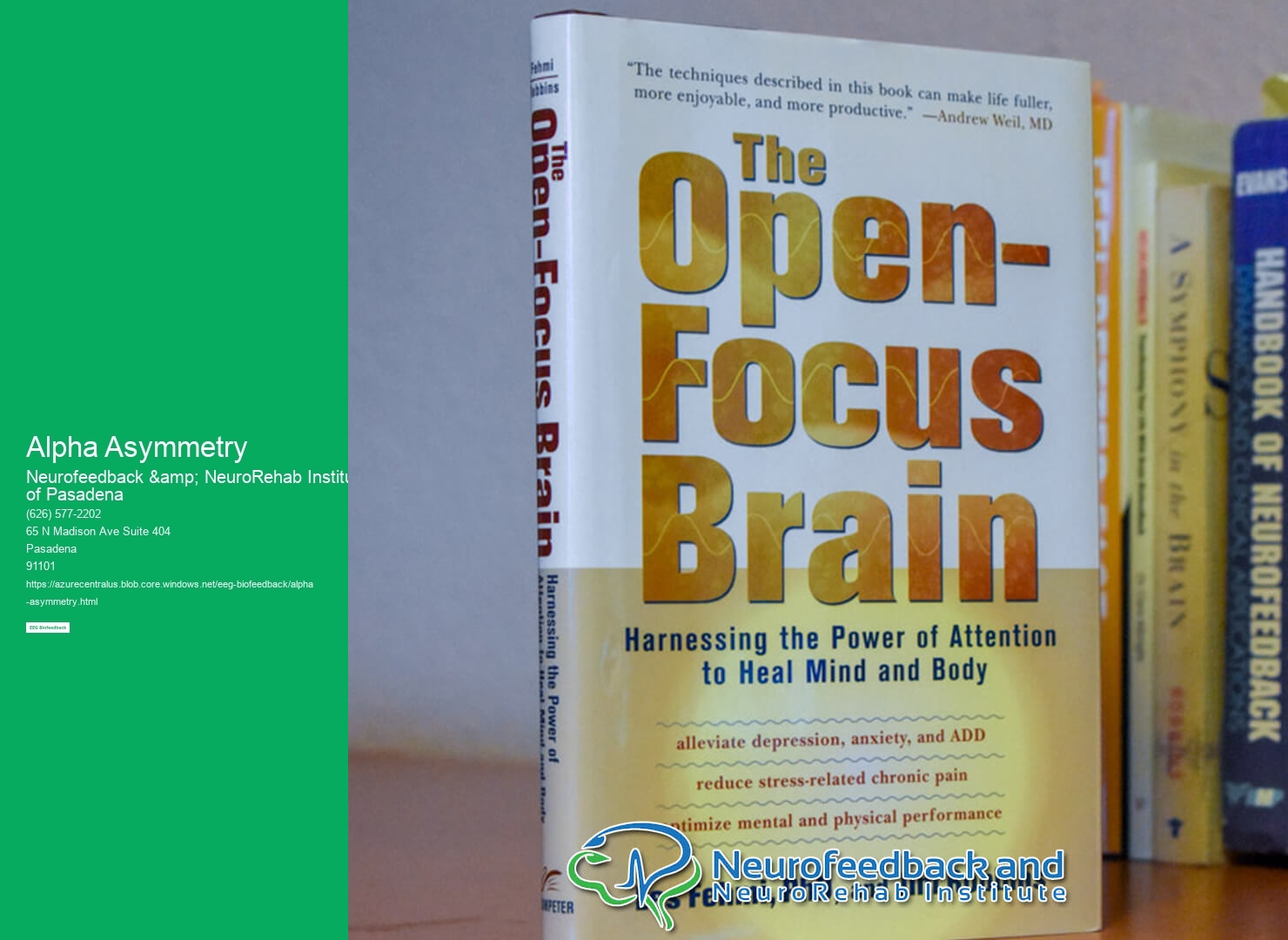

Alpha asymmetry refers to the unequal distribution of alpha brainwave activity between the left and right hemispheres of the brain. Alpha waves are a type of neural oscillation that occur in the frequency range of 8-12 Hz and are associated with a relaxed and wakeful state. Research has shown that alpha asymmetry can be indicative of underlying brain activity and has been linked to various cognitive and emotional processes. For example, greater left frontal alpha asymmetry has been associated with positive affect and approach-related behaviors, while greater right frontal alpha asymmetry has been associated with negative affect and withdrawal-related behaviors.
While alpha asymmetry has shown promise as a potential diagnostic tool for mental health disorders, it is important to note that it is not a standalone diagnostic measure. Instead, it can be used as part of a comprehensive assessment battery to provide additional information about an individual's brain functioning. Studies have found that individuals with certain mental health disorders, such as depression and anxiety, may exhibit specific patterns of alpha asymmetry. However, further research is needed to establish the reliability and validity of alpha asymmetry as a diagnostic tool and to determine its specificity for different disorders.
There are several potential causes of alpha asymmetry in the brain. One possible explanation is that it reflects underlying differences in the activation and connectivity of brain regions involved in emotional processing and regulation. For example, asymmetry in alpha activity may be influenced by the relative activation of the prefrontal cortex, which plays a key role in emotional regulation. Additionally, individual differences in alpha asymmetry may be influenced by genetic factors, early life experiences, and environmental factors such as stress and trauma. However, more research is needed to fully understand the complex mechanisms underlying alpha asymmetry.

Research has shown that individuals with anxiety disorders may exhibit distinct patterns of alpha asymmetry compared to those without anxiety disorders. Specifically, individuals with anxiety disorders tend to show greater right frontal alpha asymmetry, which is associated with increased negative affect and withdrawal-related behaviors. This suggests that there may be alterations in the neural circuits involved in emotional processing and regulation in individuals with anxiety disorders. However, it is important to note that alpha asymmetry is not specific to anxiety disorders and can also be observed in other mental health conditions.
While there is limited research on interventions specifically targeting alpha asymmetry, there are interventions that have been shown to modulate alpha activity in general. For example, neurofeedback training, which involves providing individuals with real-time feedback about their brainwave activity and teaching them to self-regulate their brain activity, has been shown to be effective in modulating alpha asymmetry. Other interventions, such as mindfulness meditation and cognitive-behavioral therapy, may also have indirect effects on alpha asymmetry by promoting relaxation and emotional regulation.


External factors such as stress and medication can influence alpha asymmetry. Chronic stress has been shown to be associated with alterations in alpha asymmetry, with increased stress levels often leading to greater right frontal alpha asymmetry. Additionally, certain medications, such as benzodiazepines, have been found to modulate alpha activity. However, the specific effects of stress and medication on alpha asymmetry can vary depending on individual factors and the specific context in which they are experienced.
The research on alpha asymmetry has important implications for understanding cognitive processes and emotional regulation. By examining patterns of alpha asymmetry, researchers can gain insights into the underlying neural mechanisms involved in emotional processing and regulation. For example, greater left frontal alpha asymmetry has been associated with enhanced attentional processing and approach-related behaviors, while greater right frontal alpha asymmetry has been associated with increased vigilance to threat and withdrawal-related behaviors. Understanding these neural mechanisms can inform the development of interventions and treatments for mental health disorders that target the regulation of alpha asymmetry and promote emotional well-being.

EEG biofeedback, also known as neurofeedback, is a technique that utilizes real-time monitoring of brainwave activity to train individuals to self-regulate their brain function. In the context of peak alpha frequency training, EEG biofeedback is applied by targeting the alpha frequency range (8-12 Hz) and encouraging individuals to increase their peak alpha frequency. This is achieved by providing visual or auditory feedback based on the individual's brainwave activity, allowing them to learn how to modulate their brainwaves and increase their peak alpha frequency. By consistently practicing this training, individuals can enhance their ability to enter a relaxed and focused state, which has been associated with improved cognitive performance and overall well-being.
EEG biofeedback, also known as neurofeedback, can be self-administered with the proper training and guidance. While it is possible to use EEG equipment at home, it is recommended to seek professional guidance to ensure accurate and effective results. Professional guidance can help individuals understand how to properly set up and use the equipment, interpret the data, and develop a personalized training plan. Additionally, professionals can provide ongoing support and adjustments to the training protocol based on the individual's progress and specific needs. This ensures that the self-administered EEG biofeedback is safe, effective, and tailored to the individual's goals and requirements.
Practitioners in EEG biofeedback programs address issues of compliance and adherence through a variety of strategies and techniques. Firstly, they educate clients about the importance of compliance and adherence to the program, emphasizing the potential benefits and outcomes. They also provide clear instructions and guidelines for the program, ensuring that clients understand the expectations and requirements. Additionally, practitioners may use motivational interviewing techniques to explore and address any barriers or challenges that clients may face in adhering to the program. They may also provide ongoing support and encouragement, monitoring progress and providing feedback to keep clients engaged and motivated. Furthermore, practitioners may tailor the program to the individual needs and preferences of each client, making it more personalized and relevant. Overall, practitioners employ a comprehensive approach to promote compliance and adherence, recognizing the importance of client engagement and commitment in achieving successful outcomes.
When determining the frequency and duration of EEG biofeedback sessions, several considerations are taken into account. These include the individual's specific needs and goals, the severity and nature of their condition, and their response to previous sessions. The frequency of sessions can vary, but it is common for individuals to initially attend sessions multiple times per week, gradually reducing to once a week or every other week as progress is made. The duration of each session typically ranges from 30 minutes to an hour, depending on the individual's tolerance and attention span. It is important to strike a balance between providing enough sessions to facilitate progress and allowing for adequate rest and integration of the training.
When it comes to individual differences in response to EEG biofeedback, several considerations are taken into account. Firstly, the practitioner assesses the client's baseline EEG patterns to understand their unique brainwave activity. This helps in identifying any deviations from the norm and tailoring the biofeedback training accordingly. Additionally, factors such as age, gender, and overall health are considered as they can influence the individual's response to the training. The practitioner also takes into account the client's specific goals and needs, as well as their cognitive abilities and emotional state. By considering these individual differences, the practitioner can customize the biofeedback protocol to optimize its effectiveness and ensure the best possible outcomes for each client.
In EEG biofeedback research, several ethical considerations are taken into account to ensure the well-being and rights of participants. One important consideration is informed consent, where participants are provided with detailed information about the study, its purpose, potential risks and benefits, and their rights as participants. Researchers also ensure that participants have the freedom to withdraw from the study at any time without facing any negative consequences. Confidentiality and privacy are maintained by protecting the identity and personal information of participants. Additionally, researchers strive to minimize any potential harm or discomfort to participants during the EEG biofeedback sessions. They also adhere to ethical guidelines regarding the use of data collected, ensuring that it is used for research purposes only and that participants' identities remain anonymous. Overall, these ethical considerations help to safeguard the rights and well-being of participants in EEG biofeedback research.